What Does the Muscular System Have in It Baby Wrenckels
The rippling muscles of professional boxers or weight lifters are often the first thing that comes to listen when one hears the word musculus. Merely musculus is too the dominant tissue in the heart and in the walls of other hollow organs of the torso. In all its forms, it makes up nearly half of the body's mass.
Functions of the Muscular System
Producing motion is a mutual office of all muscle types, only skeletal muscle plays three other important roles in the body as well.
- Producing movement. Mobility of the body every bit a whole reflects the activity of the skeletal muscles, which are responsible for all locomotion; they enable usa to respond quickly to changes in the external environment.
- Maintaining posture. We are rarely aware of the skeletal muscles that maintain body posture, however they office almost continuously, making i tiny adjustment later another then that we tin can maintain an erect or seated posture despite the never-ending downward pull of gravity.
- Stabilizing joints. Equally the skeletal muscles pull on bones to cause movements, they also stabilize the joints of the skeleton; muscle tendons are extremely important in reinforcing and stabilizing joints that have poorly fitting articulating surfaces.
- Generating heat. The 4th office of muscle, generation of body heat, is a past-product of muscle activity; as ATP is used to ability muscle contraction, nearly three-quarters of its energy escape as rut and this heat is vital in maintaining normal body temperature.
Anatomy of the Muscular Arrangement
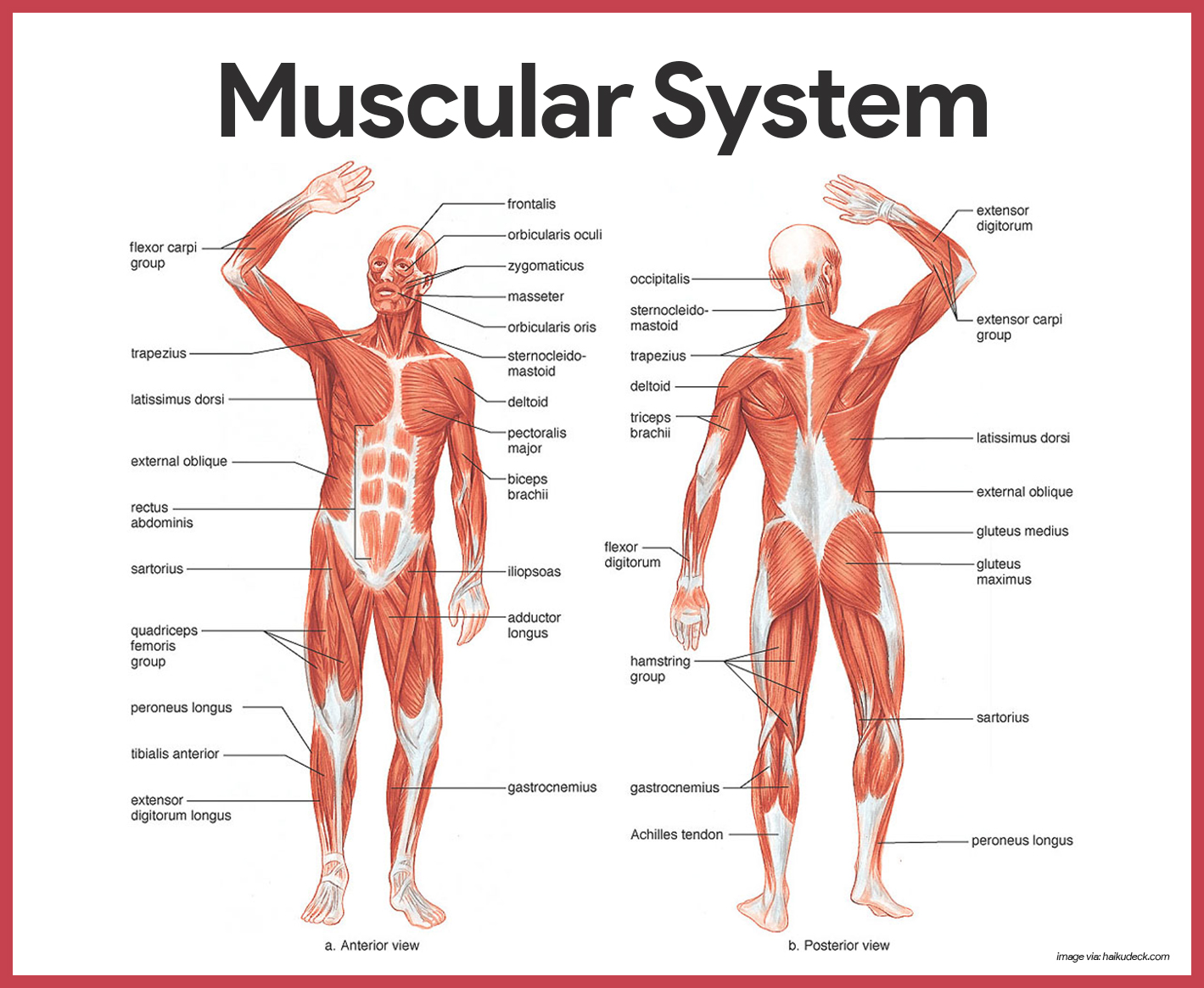
Microscopic Anatomy of Skeletal Muscle
Skeletal muscle cells are multinucleate.
- Sarcolemma. Many oval nuclei can be seen just beneath the plasma membrane, which is called the sarcolemma in muscle cells.
- Myofibrils. The nuclei are pushed aside by long ribbonlike organelles, the myofibrils, which nearly fill up the cytoplasm.
- Low-cal and dark bands. Alternating dark and low-cal bands along the length of the perfectly aligned myofibrils give the musculus prison cell as a whole its striped appearance.
- Sarcomeres. The myofibrils are actually chains of tiny contractile units called sarcomeres, which are aligned end to end like boxcars in a train along the length of the myofibrils.
- Myofilaments. There are two types of threadlike protein myofilaments within each of our "boxcar" sarcomeres.
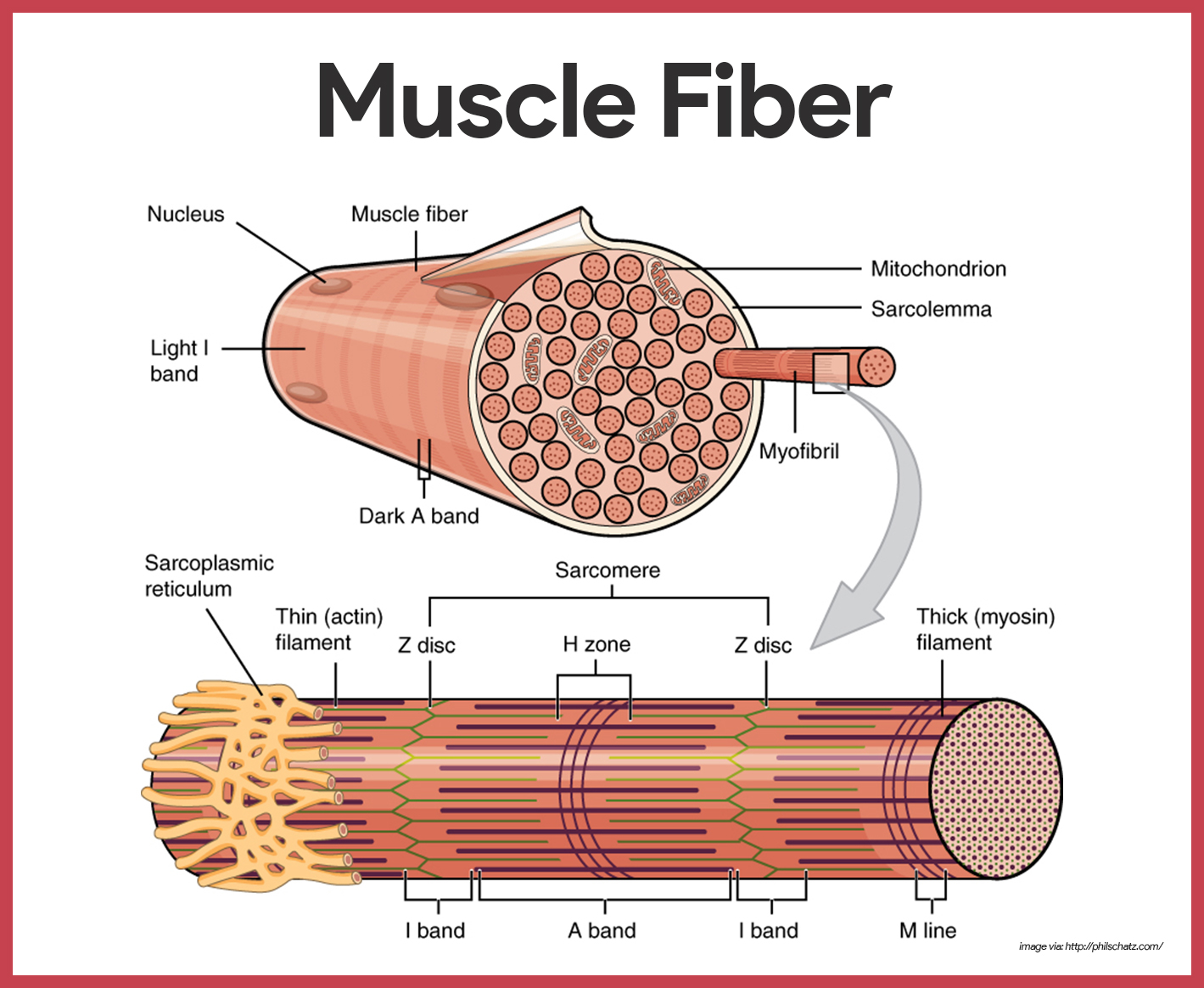
- Thick filaments. The larger, thick filaments, as well chosen myosin filaments, are made mostly of bundled molecules of the poly peptide myosin, simply they also contain ATPase enzymes, which split ATP to generate the power for muscle wrinkle.
- Cross bridges. Notice that the midparts of the thick filaments are polish, but their ends are studded with thick projections; these projections, or myosin beads, are chosen cantankerous bridges when they link the thick and thin filaments together during contraction.
- Sparse filaments. The sparse filaments are composed of the contractile protein called actin, plus some regulatory proteins that play a office in allowing (or preventing) myosin-dewdrop binding to actin; the thin filaments, too chosen actin filaments, are anchored to the Z disc (a disclike membrane).
- Sarcoplasmic reticulum. Another very important muscle fiber organelle is the sarcoplasmic reticulum, a specialized smooth endoplasmic reticulum; the interconnecting tubules and sacs of the SR surround each and every myofibril just equally the sleeve of a loosely crocheted sweater surrounds your arm, and its major office is to store calcium and to release it on demand.
Musculus Movements, Types, and Names
This section is a bit of a hodge-podge. It includes some topics that don't really fit together, but they don't fit anywhere else any better.
Types of Body Movements
Every 1 of our 600-odd skeletal muscles is attached to os, or to other connective tissue structures, at no fewer than two points.
- Origin. One of these points, the origin, is fastened to the immovable or less movable bone.
- Insertion. The insertion is attached to the movable bone, and when the muscle contracts, the insertion moves toward the origin.
- Flexion. Flexion is a motion, generally in the sagittal plane, that subtract the bending of the joint and brings two bones closer together; it is a blazon of hinge joints, but it is besides common at ball-and-socket joints.
- Extension. Extension is the reverse of flexion, so it is a motion that increases the angle, or the distance, between 2 bones or parts of the body.
- Rotation. Rotation is movement of a bone around a longitudinal axis; information technology is a common motion of ball-and-socket joints.
- Abduction. Abduction is moving the limb abroad from the midline, or median plane, of the torso.
- Adduction. Adduction is the opposite of abduction, then it is the motility of a limb toward the body midline.
- Circumduction. Circumduction is a combination of flexion, extension, abduction, and adduction commonly seen in ball-and-socket joints; the proximal end is stationary, and its distal end moves in a circle.
Special Movements
Certain movements do not fit into any of the previous categories and occur at only a few joints.
- Dorsiflexion and plantar flexion. Lifting the pes and so that its superior surface approaches the shin is called dorsiflexion, whereas depressing the foot is called plantar flexion.
- Inversion and eversion. To invert the foot, turn the sole medially; to evert the foot, turn the sole laterally.
- Supination and pronation. Supination occurs when the forearm rotates laterally and then that the palm faces anteriorly and the radius and ulna are parallel; pronation occurs when the forearm rotates medially and then that the palm faces posteriorly.Opposition. In the palm of the paw, the saddle joint between metacarpal i and the carpals allows opposition of the thumb.
Interactions of Skeletal Muscles in the Torso
Muscles are arranged in such a manner that whatever i musculus can exercise, other muscles tin contrary. Because of this, muscles are able to bring about an immense multifariousness of movements.
- Prime number mover. The muscle that has the major responsibility for causing a item move is called the prime mover.
- Antagonists. Muscles that oppose or reverse a move are antagonists; when a prime mover is agile, its antagonist is stretched and relaxed.
- Synergists. Synergists help prime movers past producing the same motility or by reducing undesirable movements.
- Fixators. Fixators are specialized synergists; they agree a bone still or stabilize the origin of a prime mover then all tension can be used to move the insertion bone.
Naming Skeletal Muscles
Similar bones, muscles come in many shapes and sizes to accommodate their particular tasks in the body.
- Direction of the musculus fibers. When a muscle's name includes the term rectus (direct) its fibers run parallel to that imaginary line; the term oblique as function of a musculus'due south name tells you that the muscle fibers run obliquely (at a slant) to the imaginary line.
- Relative size of the muscle. Such terms every bit maximus (largest) , minimus (smallest), and longus (long) are oft used in the names of muscles.
- Location of the muscle. Some muscles are named for the bone with which they are associated; for instance, the temporalis and frontalis muscles overlie the temporal and frontal bones of the skull.
- Number of origins. When the term biceps, triceps, or quadriceps forms office of a muscle proper name, 1 tin can assume that the muscle has two, three, or four origins.
- Location of the muscle's origin and insertion. Occasionally, muscles are named for their attachment sites.
- Shape of the muscle. Some muscles accept a distinctive shape that helps to identify them.
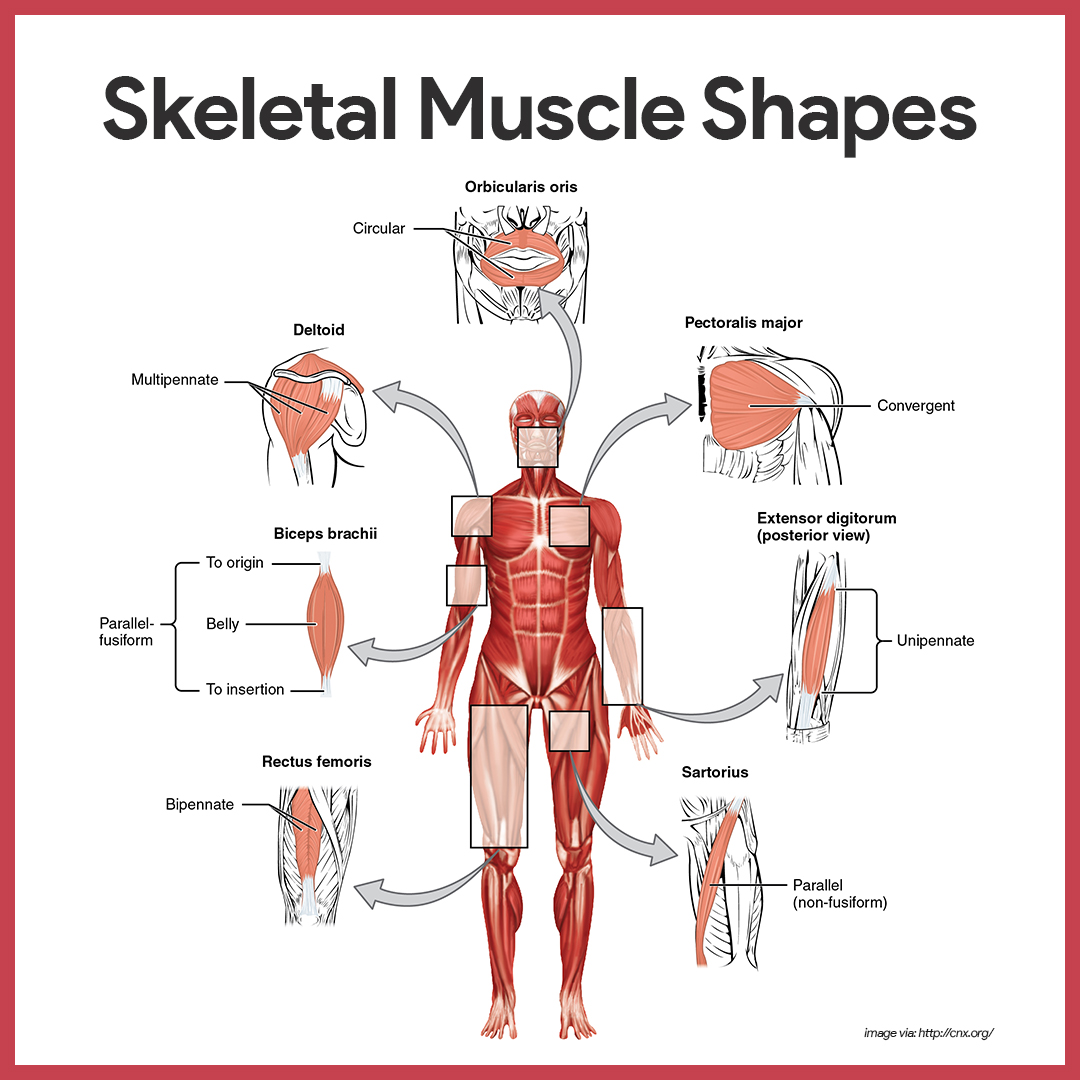
- Action of the muscle. When muscles are named for their actions, terms such as flexor, extensor, and adductor appear in their names.
Arrangement of Fascicles
Skeletal muscles consists of fascicles, merely fascicle arrangement vary, producing muscles with different structures and functional properties.
- Circular. The pattern is round when the fascicles are bundled in concentric rings; round muscles are typically institute surrounding external body openings which they close by contracting.
- Convergent. In convergent musculus, the fascicles converge toward a single insertion tendon; such a musculus is triangular or fan-shaped.
- Parallel. In a parallel arrangement, the length of the fascicles run parallel to the long axis of the muscle; these muscles are straplike; a modification of the parallel arrangement, chosen fusiform, results in a spindle-shaped muscle with an expanded abdomen.
- Pennate. In a pennate blueprint, short fascicles attach obliquely to a key tendon; in the extensor digitorium muscle of the leg, the fascicles insert into only 1 side of the tendon and the musculus is unipennate; if the fascicles insert into reverse sides of the tendon or from from several unlike sides, the muscle is bipennate or multipennate.
Gross Anatomy of Skeletal Muscles
Only the most important muscles are described hither considering it is beyond our scope to draw the hundreds of skeletal muscles of the man body.
Head and Neck Muscles
The caput muscles are an interesting group because they have many specific functions but are usually grouped into two large categories- facial muscles and chewing muscles.
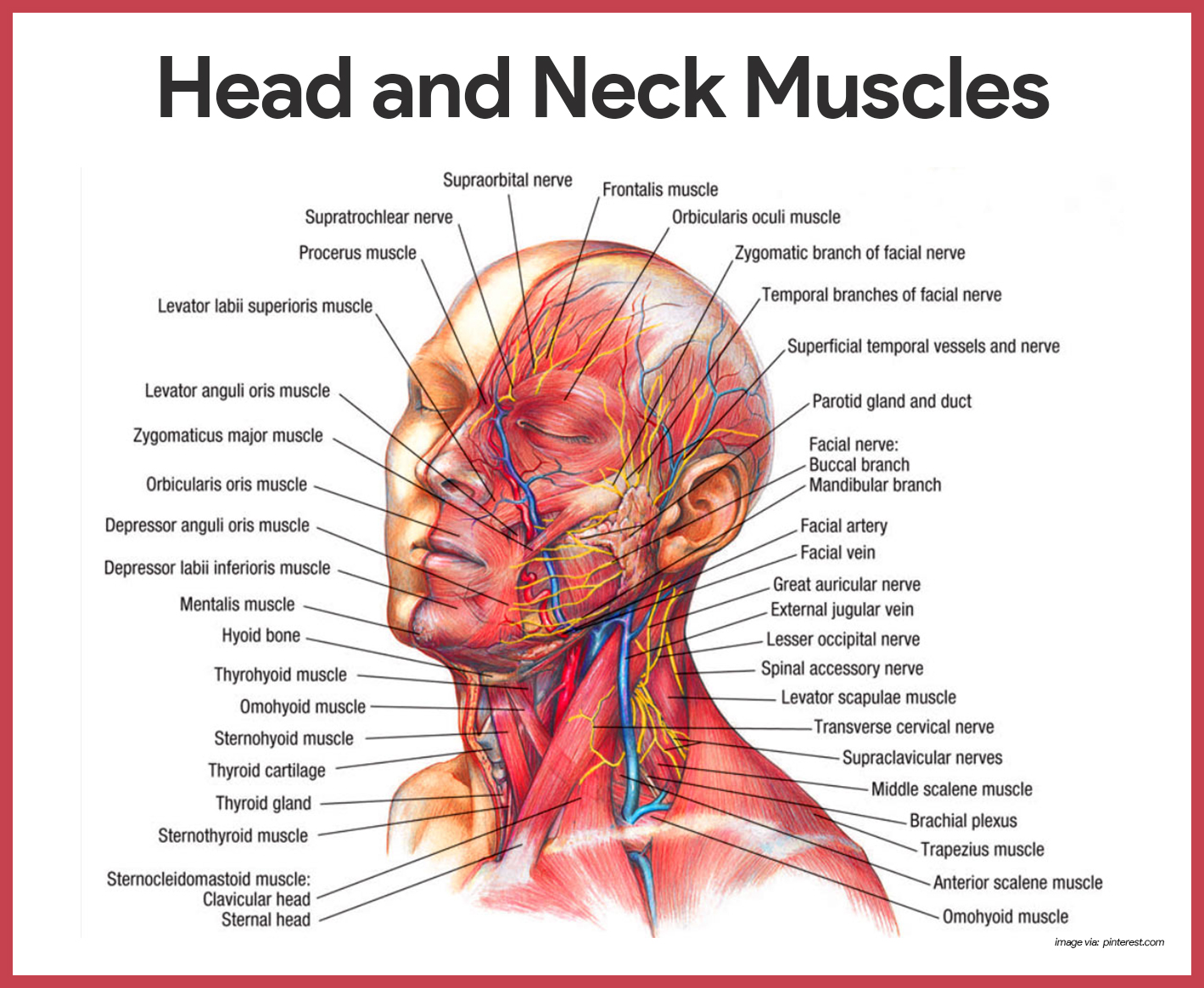
Facial Muscles
At that place are 5 facial muscles:
- Frontalis. The frontalis, which covers the frontal bone, runs from the cranial aponeurosis to the peel of the eyebrows, where it inserts; this muscle allows you to heighten your eyebrows and wrinkle your brow; at the posterior end of the cranial aponeurosis is the small-scale occipitalis muscle.
- Orbicularis occuli. The orbicularis oculi has fibers that run in circles around the eyes; it allows y'all to close your eyes, squint, blink, and flash.
- Orbicularis oris. The orbicularis oris is the circular muscle of the lips; considering information technology closes the oral cavity and protrudes the lips, it is oftentimes called the "kissing" muscle.
- Buccinator. The fleshy buccinator muscle runs horizontally across the cheek and inserts into the orbicularis oris.
- Zygomaticus. The zygomaticus extends from the corner of the mouth to the cheekbone; it is often referred to as the "smiling" muscle because it raises the corners of the mouth upwardly.
Chewing Muscles
The buccinator muscle, which is a member of this grouping, is described with the facial muscles.
- Masseter. Every bit it runs from the zygomatic procedure of the temporal os to the mandible, the masseter covers the angle of the lower jaw; this muscle closes the jaw by elevating the mandible.
- Temporalis. The temporalis is a fan-shaped muscle overlying the temporal bone; it inserts into the mandible and acts as a synergist of the masseter in closing the jaw.
Neck Muscles
For the most part, the neck muscles, which movement the head and shoulder girdle, are modest and straplike. But 2 neck muscles are considered hither.
- Platysma. The platysma is a single, sheetlike muscle that covers the anterolateral neck; its activeness is to pull the corners of the oral fissure inferiorly, producing a downwards sag of the mouth.
- Sternocleidomastoid. The paired sternocleidomastoid muscles are ii-headed muscles, 1 found on each side of the neck; when both sternocleidomastoid contract together, they flex your neck.
Trunk Muscles
The trunk muscles include (i) those that motility the vertebral column; (2) anterior thorax muscles, which move the ribs, head, and arms; and (3) muscles of the abdominal wall, which help to motion the vertebral column and, most important, form the muscular "natural girdle" of the abdominal body wall.
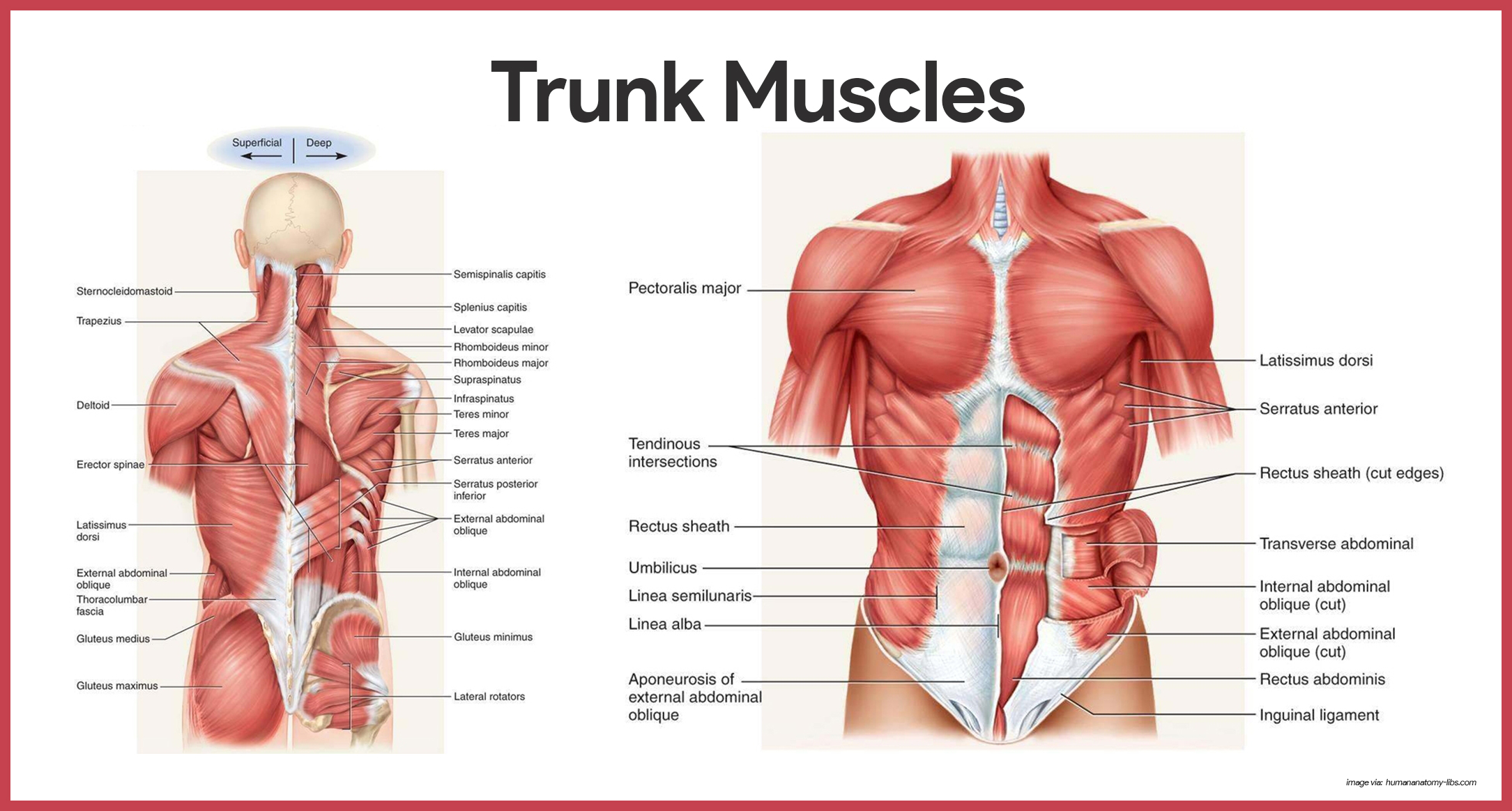
Anterior Muscles
The inductive muscles of the trunk include:
- Pectoralis major. The pectoralis major is a large, fan-shaped muscle roofing the upper office of the chest; this muscle forms the anterior wall of the axilla and acts to adduct and flex the arm.
- Intercostal muscles. The intercostal muscles are deep muscles plant between the ribs; the external intercostals are of import in breathing considering they help you lot to raise the rib cage when you inhale; the internal intercostals, which lie deep to the external intercostals, depress the rib cage, which helps to move air out of the lungs when y'all exhale forcibly.
- Muscles of the abdominal girdle. The inductive intestinal muscles (rectus abdominis, ecternal and internal obliques, and transversus abdominis) form a "natural girdle" that reinforces the body trunk; the paired straplike rectus abdominis muscles are the most superficial muscles of the abdomen; the external oblique muscles are paired superficial muscles that make upwards the lateral walls of the abdomen; the internal oblique muscles are paired muscles deep to the external obliques; and the transversus abdominis is the deepest muscle of the intestinal wall and has fibers that run horizontally beyond the abdomen.
Posterior Muscles
The posterior muscles of the body include:
- Trapezius. The trapezius muscles are the most superficial muscles of the posterior neck and upper trunk; the trapezius muscles extend the caput; they besides tin can elevate, depress, adduct, and stabilize the scapula.
- Latissimus dorsi. The latissimus dorsi muscles are the ii big, flat muscles that cover the lower back; these are very of import muscles when the arm must be brought downwards in a power stroke.
- Erector spinae. The erector spinae grouping is the prime mover of back extension; these muscles not only act as powerful back extensors but likewise provide resistance that helps control the activeness of angle over at the waist.
- Quadratus lumborum. The fleshy quadratus lumborum muscles form function of the posterior abdominal wall; interim separately, each muscle of the pair flexes the spine laterally; acting together, they extend the lumbar spine.
- Deltoid. The deltoids are fleshy, triangle-shaped muscles that form the rounded shape of the shoulders; the deltoids are the prime movers of arm abduction.
Muscles of the Upper Limb
The upper limb muscles autumn into three groups. The offset group arise from the shoulder girdle and cross the shoulder joint to insert into the humerus. The 2nd group causes movement at the elbow joint. The tertiary group includes the muscles of the forearm.

Muscles of the Humerus that Act on the Forearm
All anterior arm muscles cause elbow flexion. In social club of decreasing strength, these are the brachialis, biceps brachii, and brachioradialis.
- Biceps brachii. The biceps brachii is the nearly familiar muscle of the arm considering it bulges when the elbow is flexed; this musculus is the powerful prime number mover for flexion of the forearm and acts to supinate the forearm.
- Brachialis. The brachialis lies deep to the biceps musculus and is as important as the biceps in the elbow portion; the brachialis lifts the ulna as as the biceps lift the radius.
- Brachioradialis. The brachioradialis is a fairly weak muscle that arises on the humerus and inserts into the distal forearm.
- Triceps brachii. The triceps brachii is the only muscle fleshing out the posterior humerus; being the powerful prime number mover of elbow extension, information technology is the antagonist of biceps brachii.
Muscles of the Lower Limb
Muscles that act on the lower limb cause motility at the hip, knee and foot joints. They are amidst the largest and strongest musculus in the body and are specialized for walking and balancing the body.
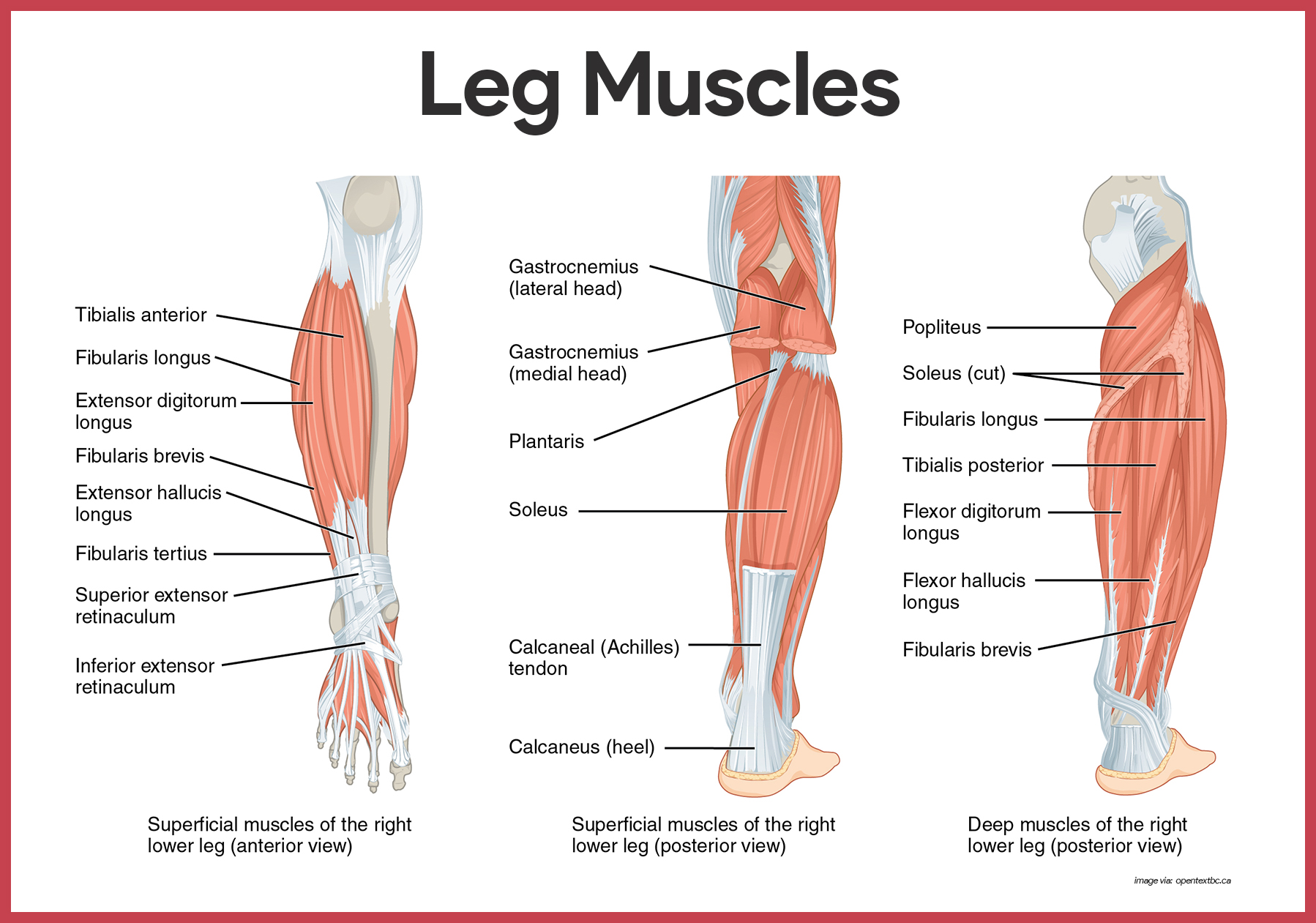
Muscles Causing Motility at the Hip Joint
Part of the muscles of the lower limb are the muscles at the hip joint.
- Gluteus maximus. The gluteus maximus is a superficial muscle of the hip that forms most of the mankind of the buttock; it is a powerful hip extensor that acts to bring the thigh in a straight line with the pelvis.
- Gluteus medius. The gluteus medius runs from the iliac to the femur, beneath the gluteus maximus for most of its length; the gluteus medius is a hip abductor and is important in steadying the pelvis during walking.
- Iliopsoas. The iliopsoas is a fused musculus composed of 2 muscles, the iliacus and the psoas major; information technology is a prime mover of hip flexion and also acts to go along the upper body from falling backward when nosotros are standing erect.
- Adductor muscles. The muscles of the adductor group course the muscle mass at the medial side of each thigh; as their name indicates, they adduct, or press, the thighs together.
Muscles Causing Motion at the Knee Articulation
The muscles of the lower limb that causes movement of the knee joint are:
- Hamstring group. The muscles forming the muscle mass of the posterior thigh are the hamstrings; the group consists of iii muscles, the biceps femoris, semimembranosus, and semitendinosus, which originate on the ischial tuberosity and run down the thigh to insert on both sides of the proximal tibia.
- Sartorius. It is the most superficial muscle of the thigh; it acts as a synergist to bring about the cross-legged position.
- Quadriceps group. The quadriceps group consists of four muscles- the rectus femoris muscle and 3 vastus muscles– that flesh out the anterior thigh; the group as a whole acts to extend the knee powerfully.
Muscles Causing Movement at the Ankle and Foot
In that location are 5 muscles that cause move at the ankle and foot:
- Tibialis anterior. The tibialis anterior is a superficial muscle on the inductive leg; it arises from the upper tibia and so parallels the anterior crest every bit information technology runs to the tarsal bones.
- Extensor digitorum longus. Lateral to the tibialis anterior, the extensor digitorum longus muscle arises from the lateral tibial condyle and proximal radius; it is a prime mover of toe extension and a dorsiflexor of the foot.
- Fibularis muscles. The 3 fibularis muscles- longus, brevis, and tertius- are establish on the lateral part of the leg; the group as a whole plantar flexes and everts the foot.
- Gastrocnemius. The gastrocnemius muscle is a two-bellied muscle that forms the curved half of the posterior leg; information technology is a prime mover for plantar flexion of the foot.
- Soleus. Deep to the gastrocnemius is the fleshy soleus muscle; because information technology arises from the tibia and fibula, it does not bear upon human knee motility.
Physiology of the Muscular Organization
Skeletal Muscle Activity
Musculus cells take some special functional properties that enable them to perform their duties.
Nerve Stimulus and the Activeness Potential
To contract, skeletal muscle cells must exist stimulated by nerve impulse.
- Neurotransmitter. When a nervus impulse reaches the axon terminals, a chemical referred to as the neurotransmitter is released; the specific neurotransmitter that stimulate skeletal muscle cells is acetylcholine, or ACh.
- Temporary permeability. If enough acetylcholine is released, the sarcolemma at that point becomes temporarily more permeable sodium ions, which blitz into the musculus cell, and to potassium ions, which diffuse out of the prison cell.
- Action potential. More than channels in the sarcolemma open up to let just sodium to enter, which generates an electrical current called an action potential; once the activeness is begun, it is unstoppable; information technology travels over the unabridged surface of the sarcolemma, conducting the electric impulse from one end of the cell to the other; the upshot id wrinkle of the muscle cell.
- Interruption down of enzymes. Acetylcholine, which began the process of muscle contraction, is cleaved downward to acetic acid and choline past enzymes nowadays on the sarcolemma; for this reason, a unmarried nervus impulse produces simply one contraction; the musculus cell relaxes until stimulated by the next round of acetylcholine release.
Machinery of Musculus Contraction: The Sliding Filament Theory
When muscle fibers are activated by the nervous system, the myosin heads attach to binding sites on the thin filaments, and the sliding begins.
- Relaxed muscle cell. In a relaxed muscle cell, the regulatory proteins forming part of the actin myofilaments prevent myosin bounden; when an activeness potential sweeps along its sarcolemma and a muscle prison cell is excited, calcium ions are released from intracellular storage areas.
- Contraction trigger. The flood of calcium acts equally the final trigger for contraction, because as calcium binds to the regulatory proteins on the actin filaments, they alter both their shape and their position on the thin filaments.
- Attachment. The concrete attachment of myosin to actin "springs the trap", causing the myosin heads to snap toward the center of the sarcomere; because actin and myosin are firmly spring to each other when this happens, the thin filaments are slightly pulled toward the center of the sarcomere.
Practice Quiz: Muscular System Anatomy and Physiology
Here's a 10-item quiz about the study guide. Please visit our nursing examination bank page for more NCLEX practice questions.
1. It is a threadlike structure that extends from one stop of the musculus cobweb to another:
A. Sarcomere
B. Sarcolemma
C. Myofibril
D. Myofilament
one. Respond: C. Myofibril
- Choice C: Myofibrilsouth are composed of long proteins including actin, myosin, and titin, and other proteins that hold them together. These proteins are organized into thick and thin filaments called myofilaments, which echo along the length of the myofibril in sections chosen sarcomeres.
- Choice A: Sarcomere is the basic unit of striated muscle tissue.
- Selection B: Sarcolemma is the fine transparent tubular sheath that envelops the fibers of skeletal muscles.
- Option D: Myofilaments are the filaments of myofibrils, synthetic from proteins, principally myosin or actin.
2. Which is NOT a function of muscles?
A. cause movement
B. produce heat
C. absorb nutrients
D. maintain posture
2. Reply: C. absorb nutrients
- Pick C: This is a function of the digestive system. Ship of digested end products from the lumen of the GI tract to the blood or lymph is absorption, and for assimilation to happen, the digested foods must start enter the mucosal cells by active or passive transport processes.
- Options A, B, and D: These are functions of the muscular system.
3. A type of muscle that aids muscles past producing the aforementioned movement or by reducing undesirable or unnecessary movement:
A. Fixators
B. Synergists
C. Antagonists
D. Prime Mover
3. Answer: B. Synergists
- Pick B: Synergists assistance prime number movers by producing the same motion or past reducing undesirable movements.
- Pick A:Fixators are specialized synergists; they hold a bone still or stabilize the origin of a prime mover so all tension can exist used to move the insertion bone.
- Option C: Muscles that oppose or reverse a motion are antagonists ; when a prime mover is agile, its antagonist is stretched and relaxed.
- Option D: The muscle that has the major responsibleness for causing a particular movement is called the prime mover .
4. The musculus that allows an private to raise his eyebrows is called:
A. orbicularis oculi
B. orbicularis oris
C. occipitofrontalis
D. levator labii superioris
E. zygomaticus
4. Answer: C. occipitofrontalis
- Choice C: The occipitofrontalis raises the eyebrows. The occipital and frontal portions of the muscle are continued by the epicranial (galea) aponeurosis.
- Option A: The orbicularis oculi encircle the eyes, tightly close the eyelids, and cause "crow's feet" wrinkles in the skin at the lateral corners of the eyes.
- Choice B: The orbicularis oris , which encircles the mouth, and the buccinator are sometimes called the kissing muscles because they crease the mouth. The buccinator also flattens cheeks as in whistling or blowing a trumpet and is therefore sometimes called the trumpeter'due south muscle.
- Option D: Sneering is achieved past the levator labii superioris because the musculus elevates one side of the upper lip, and frowning or pouting largely past the depressor anguli oris , which depresses the corner of the mouth.
- Option E: Grin is accomplished primarily by the zygomaticus muscles , which elevate the upper lip and corner of the mouth.
5. The iv pairs of muscles of chewing or mastication are:
A. temporalis, masseter, pterygoid, and buccinator
B. masseter, pterygoid, and ii pairs of temporalis
C. temporalis, pterygoid, and 2 pairs of masseter
D. temporalis, masseter, and 2 pairs of pterygoid
v. Answer: D. temporalis, masseter, and 2 pairs of pterygoid
- Option D: The four pairs of muscles of chewing or mastication are some of the strongest muscles of the body. The temporalis and masseter muscles tin be easily seen and felt on the side of the head during mastication. The pterygoid muscles, consisting of two pairs, are deep to the mandible.
6. A contraction of the right sternocleidomastoid musculus will produce these types of movement:
1. Right cervical flexion
2. Right cervical rotation
iii. Left cervical flexion
4. Left cervical rotation
A. 1 and 3
B. one and four
C. 2 and 3
D. 2 and iv
six. Answer: B. 1 and 4
- Option B: Contraction of just one sternocleidomastoid muscle causes rotation of the head. Contraction of both sternocleidomastoids results in flexion of the neck or extension of the head, depending on what other neck muscles are doing.
7. A fleshy, triangle-shaped musculus that provides the rounded shape of the shoulders:
A. Trapezius
B. Deltoids
C. Biceps brachii
D. Rectus abdominis
7. Respond: B. Deltoids
- Option B: Deltoids are rounded, triangular muscles located on the uppermost part of the arms and the top of the shoulders.
- Option A: The trapezius is i of the major muscles of the back and is responsible for moving, rotating, and stabilizing the scapula (shoulder blade) and extending the head at the neck.
- Selection C: The biceps brachii is a 2-headed musculus that lies on the upper arm between the shoulder and the elbow. Both heads arise on the scapula and join to form a single muscle belly which is attached to the upper forearm.
- Option D: The rectus abdominis is a paired muscle running vertically on each side of the anterior wall of the human abdomen, equally well every bit that of another mammals.
viii. This musculus forms well-nigh of the flesh of the buttocks:
A. Gluteus maximus
B. Gastrocnemius
C. Iliopsoas
D. Sartorius
8. Answer: A. Gluteus maximus
- Choice A: The gluteus maximus , also known collectively with the gluteus medius and minimus, as the gluteal muscles, and sometimes referred to informally every bit the "glutes," is the chief extensor muscle of the hip. Its thick fleshy mass, in a quadrilateral shape, forms the prominence of the buttocks.
- Option B: The 1000 astrocnemius is a very powerful superficial bipennate muscle that is in the back office of the lower leg. Information technology runs from its two heads just higher up the knee to the heel, a 2 joint musculus. Information technology is likewise known equally the "toe dancer's" muscle.
- Option C: The iliopsoas is the strongest of the hip flexors. It is important for standing, walking, and running. It is known every bit the prime mover of hip flexion.
- Selection D: The sartorius is the longest muscle in the human body. It is a long, thin, superficial muscle that runs downwardly the length of the thigh in the inductive compartment.
9. Match the following muscles with their corresponding clarification.
1. Gastrocnemius
2. Sternocleidomastoid
3. Levator labii superioris
4. Zygomaticus
5. Buccinator
half dozen. Depressor anguli oris
7. Orbicularis oris
A. Prayer muscle
B. Kissing muscle
C. Blowing muscle
D. Toe dancer'southward muscle
E. Grinning musculus
F. Pouting muscle
M. Sneering muscle
A. D, M, A, East, C, F, B
B. D, A, 1000, E, B, F, C
C. D, A, 1000, F, C, Due east, B
D. D, A, G, East, C, F, B
ix. Answer: D. D, A, G, East, C, F, B
- Gastrocnemius — D. Toe dancer'south muscle
- Sternocleidomastoid — A. Prayer muscle
- Levator labii superioris — G. Sneering musculus
- Zygomaticus — E. Smiling muscle
- Buccinator — C. Blowing muscle
- Depressor anguli oris — F. Pouting muscle
- Orbicularis oris — B. Kissing muscle
10. Which of the following correctly identifies muscle components in order from largest to smallest?
A. Muscles — Fasciculus — Myofibrils — Musculus fibers — Myofilaments
B. Muscles — Muscle fibers — Myofibrils — Fasciculus — Myofilaments
C. Muscles — Fasciculus — Muscle fibers — Myofibrils — Myofilaments
D. Muscles — Musculus fibers — Fasciculus — Myofibrils — Myofilaments
10. Answer: C. Muscles — Fascicles — Muscle fibers — Myofibrils — Sparse and thick filaments
- Selection C: A muscle is composed of numerous visible bundles called muscle fasciculi. A fasciculus is composed of several muscle cells or muscle fibers. Each musculus cobweb is a unmarried cylindrical cell that contains several nuclei located at the periphery of the musculus fiber. The cytoplasm of the muscle fiber contains numerous myofibrils. Each myofibril is a threadlike structure that extends from one cease of the muscle fiber to the other. Myofibrils consist of two major kinds of protein fibers: actin and myosin myofilaments .
Encounter Likewise
Other beefcake and physiology study guides:
- Anatomy and Physiology: Nurse Study Guides
- Blood Anatomy and Physiology
- Cardiovascular Organization Anatomy and Physiology
- Digestive System Anatomy and Physiology
- Endocrine System Anatomy and Physiology
- Integumentary System Anatomy and Physiology
- Lymphatic System Anatomy and Physiology
- Muscular System Beefcake and Physiology
- Nervous Organization Anatomy and Physiology
- Respiratory System Beefcake and Physiology
- Skeletal System Anatomy and Physiology
- Special Senses Anatomy and Physiology
- Urinary System Anatomy and Physiology
- Female Reproductive System Anatomy and Physiology
- Male Reproductive Organisation Anatomy and Physiology
Further Reading
- Nursing Diagnosis Handbook: An Evidence-Based Guide to Planning Care
- Medical-Surgical Nursing: Assessment and Management of Clinical Bug
- Medical-Surgical Nursing: Patient-Centered Collaborative Care
- Saunders Comprehensive Review for the NCLEX-RN Examination
- Brunner & Suddarth'southward Textbook of Medical-Surgical Nursing
petersthrainater1946.blogspot.com
Source: https://nurseslabs.com/muscular-system-anatomy-physiology/
0 Response to "What Does the Muscular System Have in It Baby Wrenckels"
Post a Comment